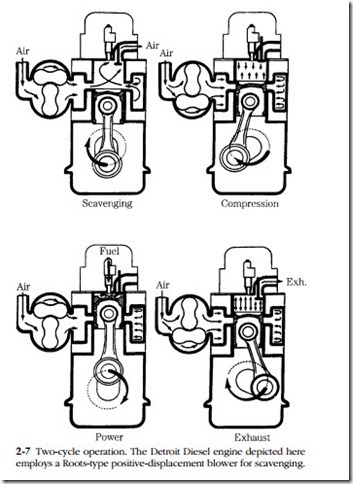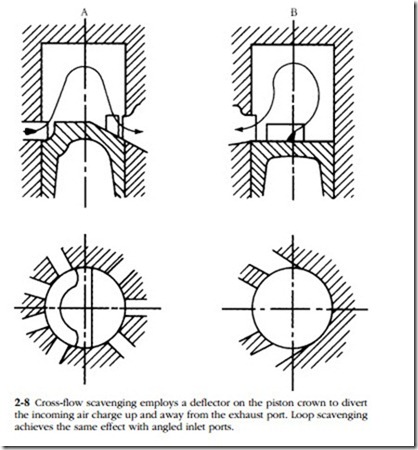Two- and four-stroke-cycle
CI and SI engines operate on similar cycles, consisting of intake, compression, expansion, and exhaust events. Four-stroke-cycle engines of either type allocate one up or down stroke of the piston for each of the four events. Two-stroke-cycle engines telescope events into two strokes of the piston, or one per crankshaft revolution. In the United States, the term stroke is generally dropped and we speak of two- or four-cycle engines; in other parts of the English-speaking world, the preferred nomenclature is two-stroke and four-stroke.
Four-cycle diesel engines operate as shown in Fig. 2-6. Air, entering around the open intake valve, fills the cylinder as the piston falls on the intake stroke. The intake valve closes as the piston rounds bdc on the compression stroke. The piston rises, compressing and heating the air to ignition temperatures.
Injection begins near tdc on the compression stroke and continues for about 40°
of crankshaft rotation. The fuel ignites, driving the piston down in the bore on the expansion, or power stroke. The exhaust valve opens and the piston rises on the exhaust stroke, purging the cylinder of spent gases. When the piston again reaches tdc, the four-stroke-cycle is complete, two crankshaft revolutions from its beginning.
Figure 2-7 illustrates the operation of Detroit Diesel two-cycle engines, which employ blower-assisted scavenging. As shown in the upper left drawing, pressurized air enters the bore through radial ports and forces the exhaust gases out through the
Two-cycle operation. The Detroit Diesel engine depicted here employs a Roots-type positive-displacement blower for scavenging.
cylinder without raising its pressure much above atmospheric. The exhaust valve remains open until the ports are closed to eliminate a supercharge effect.
The exhaust valve then closes and the piston continues to rise, compressing the air charge ahead of it. Near tdc, the injector fires, combustion begins, and cylinder pressure peaks as the piston rounds tdc. Expanding gases drive the piston down- ward. The exhaust valve opens just before the scavenge ports are uncovered to give spent gases opportunity to blow down. These four events—intake, compression, expansion, and exhaust—occur in two piston strokes, or one crankshaft revolution.
Not all two-cycle diesel engines have valves. Combining scavenge air with combustion air eliminates the intake valve, and a port above the air inlet port replaces the exhaust valve. Such engines employ cross-flow or loop scavenging (Fig. 2-8) to
purge the upper reaches of the cylinder and to minimize the loss of scavenge air to the exhaust. In the cross-flow scheme, a deflector cast into the piston crown diverts the incoming air stream away from the open exhaust port and into the stagnant region above the piston. The angled inlet ports on loop-scavenged engines produce the same effect.
It is also possible to eliminate the external air pump by using the crankcase as part of the air inlet tract. Piston movement provides the necessary compression to pump the air, via a transfer port, into the cylinder. Not many crankcase-scavenged engines are seen in this country, but the German manufacturer Fichtel & Sachs has built thousands of them.
Because two-cycle engines fire every revolution, the power output should be twice that of an equivalent four-stroke. Such is not the case, principally because of difficulties associated with scavenging. Four-cycle engines mechanically purge exhaust gases, through some 440° of crankshaft revolution. (The exhaust valve opens
early during the expansion stroke and closes after the intake valve opens). Two- cycles scavenge in a less positive manner during an abbreviated interval of about 130° Consequently, some exhaust gas remains in the cylinder to dampen combustion.


